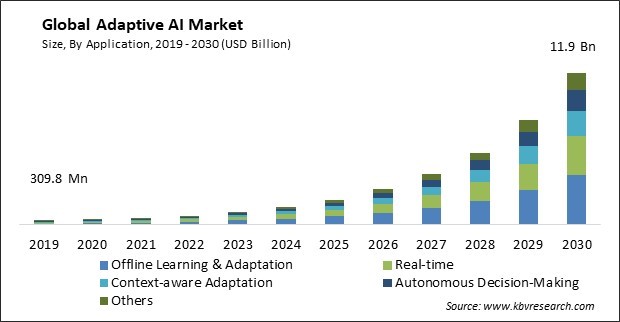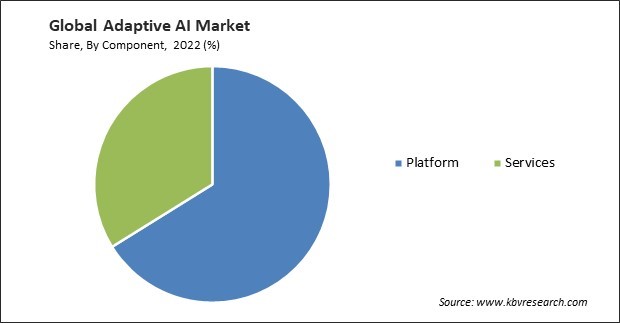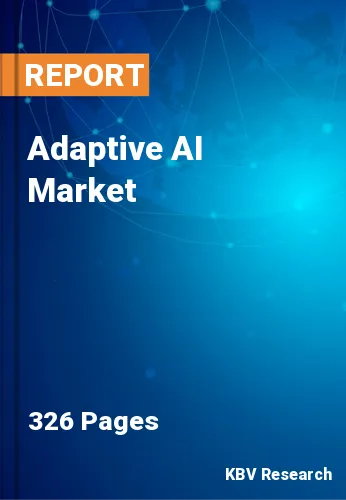The Global Adaptive AI Market size is expected to reach $11.9 billion by 2030, rising at a market growth of 42.3% CAGR during the forecast period.
Context-aware adaptation leads to more personalized and relevant user experiences. By considering the context, systems can provide information and services better aligned with user needs and preferences. Adaptive systems can optimize processes and resource allocation by responding to changing conditions. Therefore, the context-aware adaptation segment captured $118.8 million revenue in the market in 2022. This can increase efficiency in various domains, from supply chain management to energy consumption. Context-aware adaptation contributes to the automation of decision-making processes. Systems can autonomously adjust settings and behaviors, reducing the need for constant manual intervention. Some of the factors impacting the market are rapid technological advancements of adaptive AI, proliferation of data from various sources, and rising security concerns of data.

Ongoing developments in machine learning algorithms, including deep learning and reinforcement learning, contribute to increased efficiency and effectiveness in these systems. These algorithms enable AI models to learn from complex data patterns, adapt to diverse environments, and make more accurate predictions. Improvements in natural language processing techniques contribute to expanding these in applications involving human-machine interaction. Additionally, the availability of large and diverse datasets provides these systems with abundant training data. This allows these systems to learn from various examples, improving their ability to recognize patterns, make predictions, and adapt to different contexts. The availability of domain-specific data enables these systems to fine-tune their models for specific contexts. The market is poised for further growth and innovation as the digital ecosystem generates vast data.
However, these systems are susceptible to adversarial attacks, where malicious actors manipulate inputs to deceive the system. This can lead to incorrect or biased predictions, compromising the integrity of the AI model. Attackers may attempt to extract sensitive information about the training data or model parameters by probing the AI system through model inference queries. The above factors will hamper market growth in the coming years.
On the basis of component, the market is segmented into platform and services. The services segment acquired a substantial revenue share in the market in 2022. Its services excel in predictive analytics by learning from historical data to make accurate forecasts and identify trends. This is valuable in industries such as finance for predicting industry trends, healthcare for disease prognosis, and supply chain management for demand forecasting. These services are employed in cybersecurity for fraud detection and threat analysis.

Based on application, the market is fragmented into real-time, offline learning & adaptation, context-aware adaptation, autonomous decision-making, and others. In 2022, the offline learning and adaptation segment held the highest revenue share in the market. The system's ability to learn and adapt offline is crucial as it allows the system to keep becoming better even in the absence of human interactions or real-time data sources. These procedures guarantee that, in dynamic contexts, the AI system can continue to function effectively and stay current.
By technology, the market is categorized into machine learning, deep learning, natural language processing (NLP), computer vision, and others. The machine learning segment recorded a remarkable revenue share in the market in 2022. Machine learning algorithms are organized to learn and adapt continuously. In adaptive AI, continuous learning enables systems to update their models in real-time, ensuring they remain relevant and effective in dynamic scenarios. This is particularly important in predictive analytics applications, where models must evolve based on new data patterns.
Based on end-use, the market is classified into BFSI, healthcare & life sciences, IT & telecommunications, aerospace & defense, manufacturing, retail & e-commerce, media & entertainment, and others. In 2022, the BFSI segment generated the largest revenue share in the market. Prominent use of this in financial industries is driving market growth over the projection period. Fraudulent activity is a persistent threat to financial institutions. Proactive fraud detection and prevention are made possible by its ability to scan enormous volumes of data, spot patterns, and spot abnormalities in real time. Moreover, using consumer data analysis, these systems may provide highly customized banking experiences.
| Report Attribute | Details |
|---|---|
| Market size value in 2022 | USD 730.9 Million |
| Market size forecast in 2030 | USD 11.9 Billion |
| Base Year | 2022 |
| Historical Period | 2019 to 2021 |
| Forecast Period | 2023 to 2030 |
| Revenue Growth Rate | CAGR of 42.3% from 2023 to 2030 |
| Number of Pages | 326 |
| Number of Table | 519 |
| Report coverage | Market Trends, Revenue Estimation and Forecast, Segmentation Analysis, Regional and Country Breakdown, Porter’s 5 Forces Analysis, Company Profiling, Companies Strategic Developments, SWOT Analysis, Winning Imperatives |
| Segments covered | Component, Technology, Application, End-use, Region |
| Country scope |
|
| Companies Included | RisingMax Inc., Suffescom Solutions Inc., Markovate Inc., Cisco Systems, Inc., LeewayHertz, Cygnus Softwares, Inc., Ness Group of Companies, Softura, Tech Mahindra Limited, and Apexon |
| Growth Drivers |
|
| Restraints |
|
Region-wise, the market is analyzed across North America, Europe, Asia Pacific, and LAMEA. In 2022, the North America region witnessed the largest revenue share in the market. It is being widely used in healthcare in North America. Personalized treatment plans, predictive analytics, and real-time patient monitoring are all made possible by using these in hospitals and other medical facilities. Due to technology, medical professionals can always modify their diagnostic and treatment plans considering new findings in the field and information about specific patients.
Free Valuable Insights: Global Adaptive AI Market size to reach USD 11.9 Billion by 2030
The market research report covers the analysis of key stake holders of the market. Key companies profiled in the report include RisingMax Inc., Suffescom Solutions Inc., Markovate Inc., Cisco Systems, Inc., LeewayHertz, Cygnus Softwares, Inc., Ness Group of Companies, Softura, Tech Mahindra Limited, and Apexon.
By Component
By Application
By Technology
By End-use
By Geography
This Market size is expected to reach $11.9 billion by 2030.
Rapid technological advancements of adaptive AI are driving the Market in coming years, however, Rising security concerns of data restraints the growth of the Market.
RisingMax Inc., Suffescom Solutions Inc., Markovate Inc., Cisco Systems, Inc., LeewayHertz, Cygnus Softwares, Inc., Ness Group of Companies, Softura, Tech Mahindra Limited, and Apexon.
The expected CAGR of this Market is 42.3% from 2023 to 2030.
The Platform segment is registering maximum revenue in the Market by Component in 2022; thereby, achieving a market value of $7.6 billion by 2030.
The North America region is leading the segment in the Market by Region in 2022 and would continue to be a dominant market till 2030; thereby, achieving a market value of $4.2 billion by 2030.
Our team of dedicated experts can provide you with attractive expansion opportunities for your business.

